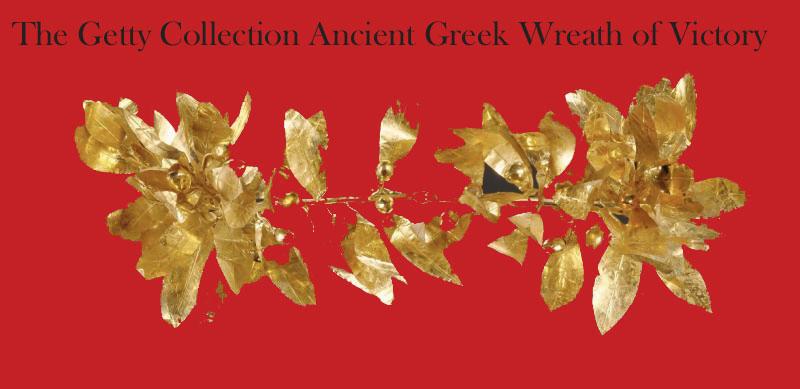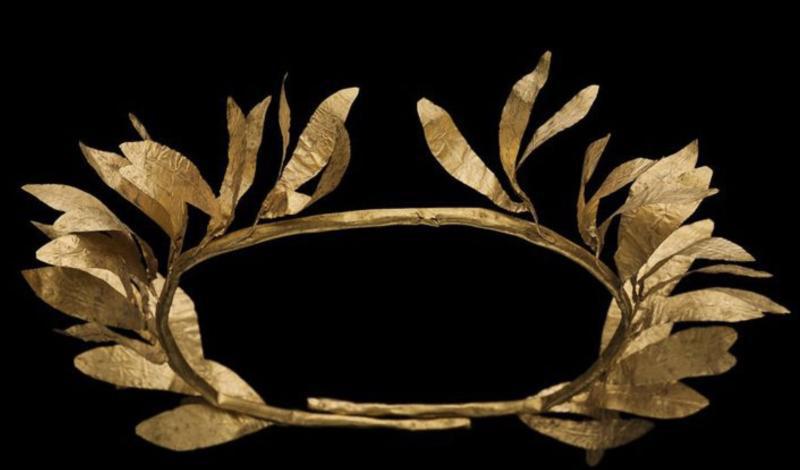A Magnificent Ancient Greek Wreath of Victory, A Crown of Hammered Gold. From the Era of Alexander The Great. Circa 300 BC. Now Re-Assembled For Our Display
An original fine sheet gold Wreath of Victory, Around 2300 years old, reassembled in our workshop over two weeks.
It is now been thus re-assembled, and display framed flat under glass, it is a magnificent historic wonder to behold. Around 2300 years old in fabulous condition overall considering the passing two plus millennia. Likely 22ct gold.
The Ancient Greek Gold Wreath of Victory
was was derived from wreaths of real leaves worn in religious ceremonies and given as prizes in athletic and artistic contests, at the point of triumph. Gold wreaths were fragile ant not meant to be frequently worn, but were definitely meant for display. See the Getty Collection for their partial view of an example of a Gold Crown of Triumph.
In Ancient Rome, in later centuries it was similarly worn on the head as a symbol of triumph. There are numerous, surviving original Roman carved sculptures of Roman Caesars and Emperors adorned with their Wreath of Victory.
The symbol of the laurel wreath is from Greek mythology. The Romans adopted the symbol because they admired Greek culture. In Rome, they were symbols of military victory.
Military commanders or emperors often wore them after a battle. Laurel wreaths in ancient times are most often shown as a horseshoe shape.
Greek goldsmiths and artisans inherited their techniques from Egypt and Mesopotamia, however, they managed to create and develop a unique style. Gold became the primary decorative material, although silver, lead, bronze and electrum were also used. Skilled artisans worked the gold in thin leaves
In Classic and Hellenistic Greece it was the advent of the Golden Age of Greece, when Hellenic culture blossomed, that Greek jewellery reached its high water mark. The reign of Alexander the Great saw an enormous influx of gold and precious stones from the Orient, providing the core resources to produce items of incredible splendour. This era was brought to an end when the Roman Empire took control of Greece in the 2nd century BC, bringing many drastic and dramatic changes in jewellery style.
Photos in the gallery show ours as we have assembled it, see photos 1, 2, 3 and how ours would likely have appeared 2300 years ago, when it was worn at the triumph see photo 7, and in the gallery we show the Massachusetts collection gold crown see pgoto 6, fully assembled, and the last photo is the Getty Collection crown photo 4.
In the gallery we show the other museum examples, in exactly how they would have looked when worn and complete. We also show one partial crown in the Getty Collection, our crown is designed with laurel leaves and some oak leaves. The Massachusetts collection, fully re-assembled example, sold in Christies in 2019 for $325,000 USD
The Somerset crown was incredibly rare gold crown believed to be more than 2,000 years old was discovered under a bed in a Somerset cottage. That was the last completely assembled example that we saw and had the opportunity to acquire. It was in 2016. The delicate Greek gold myrtle wreath, which was thought to date to 300BC, was found in a cardboard box in the modest Taunton property. When appraised by a local auction in 2016 it was estimated to be worth approaching 200,000 GBP.
We re-assembled our gold crown for our photographic display, but it will need re-assembling for whatever form of permanent display its new owner feels suits it best. It comprises of up to 100 parts of hammered gold from up 4 inches to 1/8th inch long.
Our example was from a late esteemed private collection of a famous British ‘Barrister at the Temple’ and antiquities collector, acquired in the 1960’s
Every item is accompanied with our unique, Certificate of Authenticity. Of course any certificate of authenticity, given by even the best specialist dealers, in any field, all around the world, is simply a piece of paper,…however, ours is backed up with the fact we are the largest dealers of our kind in the world, with over 100 years and four generation’s of professional trading experience behind us
Code: 24772
8950.00 GBP








